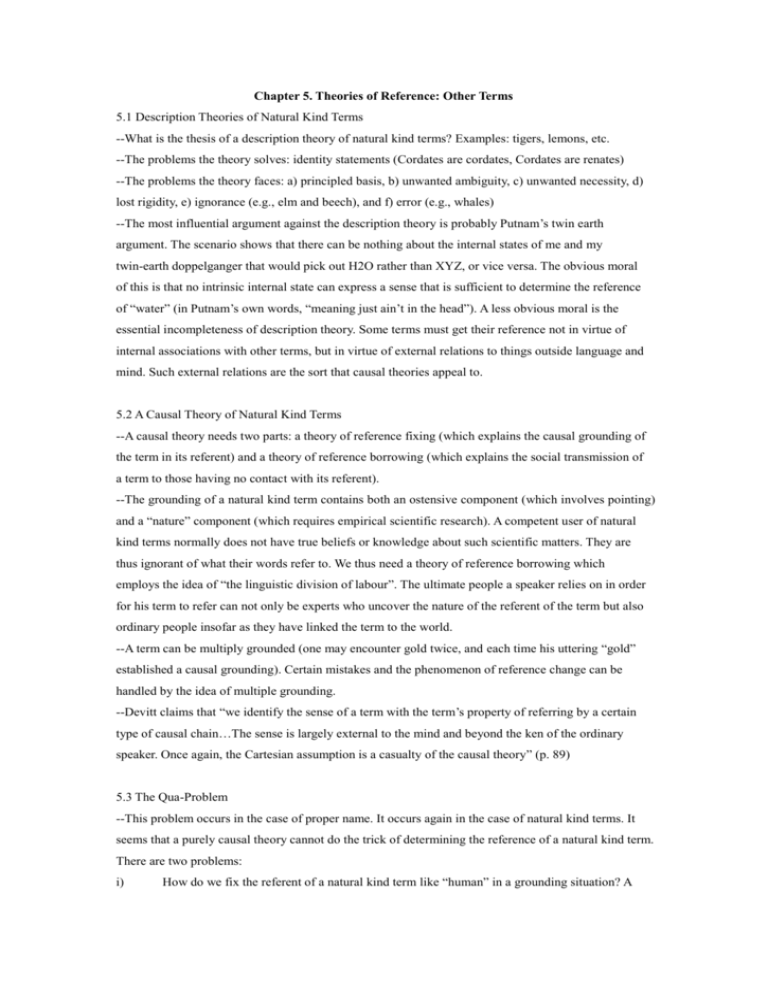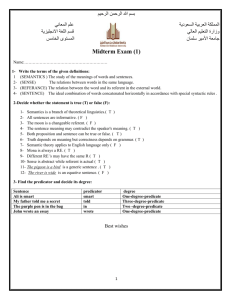Chapter 5. Theories of Reference: Other Terms 5.1 Description
advertisement

Chapter 5. Theories of Reference: Other Terms 5.1 Description Theories of Natural Kind Terms --What is the thesis of a description theory of natural kind terms? Examples: tigers, lemons, etc. --The problems the theory solves: identity statements (Cordates are cordates, Cordates are renates) --The problems the theory faces: a) principled basis, b) unwanted ambiguity, c) unwanted necessity, d) lost rigidity, e) ignorance (e.g., elm and beech), and f) error (e.g., whales) --The most influential argument against the description theory is probably Putnam’s twin earth argument. The scenario shows that there can be nothing about the internal states of me and my twin-earth doppelganger that would pick out H2O rather than XYZ, or vice versa. The obvious moral of this is that no intrinsic internal state can express a sense that is sufficient to determine the reference of “water” (in Putnam’s own words, “meaning just ain’t in the head”). A less obvious moral is the essential incompleteness of description theory. Some terms must get their reference not in virtue of internal associations with other terms, but in virtue of external relations to things outside language and mind. Such external relations are the sort that causal theories appeal to. 5.2 A Causal Theory of Natural Kind Terms --A causal theory needs two parts: a theory of reference fixing (which explains the causal grounding of the term in its referent) and a theory of reference borrowing (which explains the social transmission of a term to those having no contact with its referent). --The grounding of a natural kind term contains both an ostensive component (which involves pointing) and a “nature” component (which requires empirical scientific research). A competent user of natural kind terms normally does not have true beliefs or knowledge about such scientific matters. They are thus ignorant of what their words refer to. We thus need a theory of reference borrowing which employs the idea of “the linguistic division of labour”. The ultimate people a speaker relies on in order for his term to refer can not only be experts who uncover the nature of the referent of the term but also ordinary people insofar as they have linked the term to the world. --A term can be multiply grounded (one may encounter gold twice, and each time his uttering “gold” established a causal grounding). Certain mistakes and the phenomenon of reference change can be handled by the idea of multiple grounding. --Devitt claims that “we identify the sense of a term with the term’s property of referring by a certain type of causal chain…The sense is largely external to the mind and beyond the ken of the ordinary speaker. Once again, the Cartesian assumption is a casualty of the causal theory” (p. 89) 5.3 The Qua-Problem --This problem occurs in the case of proper name. It occurs again in the case of natural kind terms. It seems that a purely causal theory cannot do the trick of determining the reference of a natural kind term. There are two problems: i) How do we fix the referent of a natural kind term like “human” in a grounding situation? A person pointed to may also be a bachelor? Why isn’t the referent of “human” turn out to be all bachelors? Something must be going on that makes the nature-determining evolutionary origin of the sample relevant to the future reference of the term in a way that it is not relevant to the future reference of “bachelor”. --This something is the intention or belief of the speaker that the sample is a member of a natural kind, and the speaker intends to apply the term to the sample as such a member. ii) The term is applied to the sample not only qua member of a natural kind but also qua member of one particular natural kind. In virtue of what is the grounding in it qua member of one rather than another natural kind? As a result of groundings, a term refers to all objects having the same underlying nature as the objects in the sample. But which underlying nature? The sample shares many. --The speaker may think of the sample as member of the class of objects that possess the same cause of “O” where O are the typical characteristics and powers of the sample. It is by virtue of this mental act that determines the referent of a natural kind term. 5.4 Other Kind Terms --Can the causal theory be applied to other terms such as artifactual and sociolegal terms, such as “pencil” and “pediatrician”? Putnam thinks that it can, but the description theory can’t. Putnam gives some thought experiments to refute the description theory, but Devitt, following Schwartz, points out that it does not succeed. See p. 93-4. --But does this mean that a description theory is applicable to these two kinds of terms? Devitt, following Burge’s famous thought experiments, argues that no. Burge’s arguments show that here the problems of error and ignorance occur again. See p. 95-6. 5.5 Hybrid Theories There can be different combinations of causal and description theoretical components employed in the reference fixing and the reference borrowing parts of a theory. But any combination will face the qua problem and the essentially incomplete problem. See p. 96-101 Quiz 5. 1. What is the thesis of a description theory of natural kind terms? Give an example to illustrate the thesis. The description theory faces the problem of ignorance and the problem of error. Use the “elm”/”beech” case and the “whale” case to explain the two problems respectively. 2. What is Putnam’s twin earth argument and how does it refute a description theory of natural kind terms? 5.6 Analyticity, Apriority, and Necessity (this is a very brief and rough section) There are two kinds of true sentences: one kind of sentence is true in virtue of its meaning (analytic sentences), while another kind true in virtue of its meaning and the world (synthetic). E.g., (A) All bachelors are unmarried. (S) Dogs are friendly. The sentence (A) is logically true because “bachelors” can be substituted by a synonymous term “unmarried men” into (L): All unmarried men are unmarried. --Analyticity explains apriority Some philosophers think that analyticity can explain apriority because one can know a priori the truth of an analytic sentence simply by reflectively thinking that the meaning of “unmarried” is contained in the meaning of “bachelor”. There are two problems with this view: 1) It requires the Cartesian assumption, which is rejected by the causal theory. 2) Knowledge about the meaning of “bachelor” is not sufficient for knowledge of (A); one also has to have knowledge that (L): “all unmarried men are unmarried” is true. Besides, no satisfactory account of apriority has been offered yet. --Analyticity explains necessity 5.7. Donnellan’s Distinction Definite descriptions are ambiguous. Donnellan distinguishes two senses of definite descriptions: consider the case of the murderer (p. 104) 1) Attributive use (this is Russell’s theory: the reference of a description depends on unique application of the description) 2) Referential use (a description is used by a speaker to refer to someone directly; the reference of the description depends on which object the speaker has in mind. The referential use of a definite description is similar to a proper name in a causal theory. More discussion on this point in the next section) 5.8 Designational Terms --What are the mechanisms of a referential description? Devitt’s tentative answer: a causal d-chain--it shares a same mechanism of a proper name characterized by a causal theory. (p. 105-6) --Demonstratives (e.g., “this”, “that”, and pronouns, e.g., “he”, “she”, “it”) 1. deictic: point to something or demonstrate 2. anaphorical: cross-refer to something previously mentioned Some argue for the deictic use of demonstratives. Devitt disagrees, because pointing is too vague to fix the referent. Also, a referent is often not around for pointing. Devitt suggests that what is needed is a speaker’s having some perceptual experience of the referent when the speaker uses a demonstrative. But apparently demonstratives encounter the qua problem as well. A causal-descriptive theory is needed. --Complex demonstratives: E.g., “that man”: it has a mechanism of reference which is partly causal (“that” is causally grounded in the referent), and partly descriptive (“man” applies to the referent). But as a demonstrative, the causal or deictic part is more substantial. --Incomplete descriptions: E.g., “the book”, “the table”: it has causal and descriptive components. A Russelling would say that a term like “the book” is elliptical: a speaker has in mind a longer description, which, if asked, she would produce to complete the brief description uttered. But this will face the problems of principled basis, of error and ignorance, etc. Alternatively, a Devittian would give a causal-descriptive theory in which the referent of “the book” depends partly on the application of the term but largely on a d-chain grounded in the book in question. (p. 107) The moral of the discussions about various designational terms, is that all of them depend their referents on d-chains. These singular terms differ in that they contain different degrees of descriptive contents. A spectrum: from this, that, that man, the man, to very complex descriptions such as the murderer of Smith, etc.






